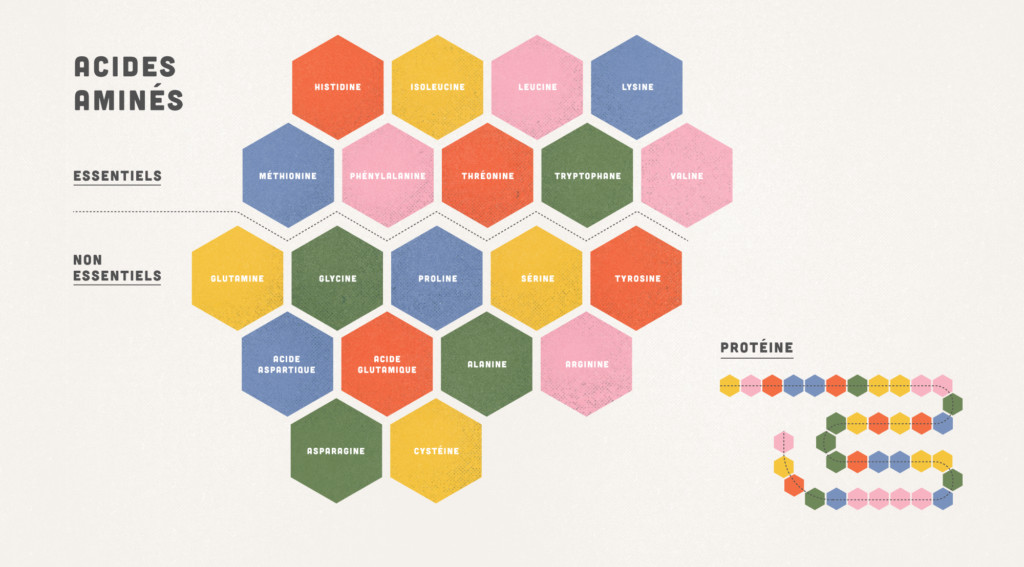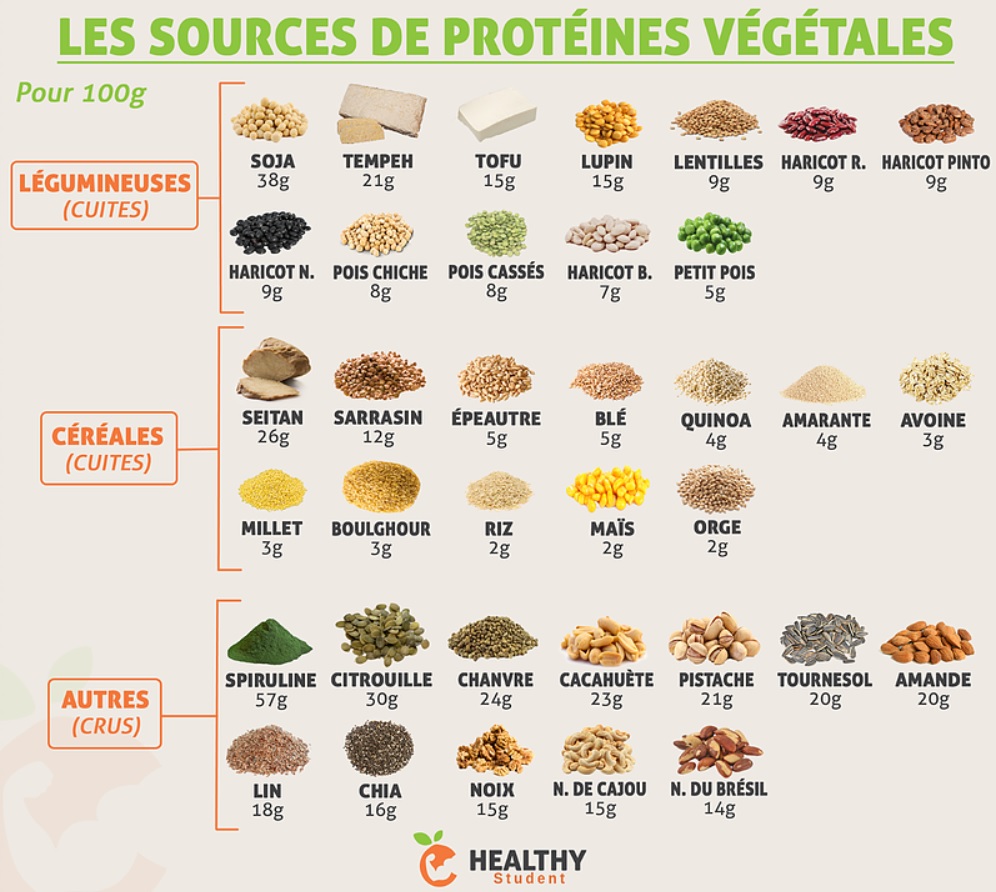In this chapter Nutrition basics (Part 1 of the Blooness guide)but also Contents of the Mediterranean diet guide (Part 3 of the Blooness guide)we are going to address the crucial question of proteinsthese macronutrients essential for the constitution of human tissue.
Table of contents
Hide- 1.Free audio / podcast content
- 2.Protein definition and benefits
- 3.Protein composition
- 4.Protein-rich foods
- 5.How much energy do proteins provide in terms of kcal?
- 6.To sum up the energy content of proteins
- 7.Recommended protein intake
- 8.What you'll learn in the second part, dedicated to proteins and reserved for Blooness members.
First, we'll define what a protein isbefore looking at how this molecule works, its virtues, and its generally recommended daily intake.
The first part of this content will be accessible to allwhile the second part - reserved for Blooness members and which has just been added - is denser, with a much more in-depth and practical approach to optimal protein intakes for different situations (Mediterranean diet, ketogenicsports enthusiasts, senior citizens).
Free audio / podcast content
Protein definition and benefits
Visit proteins are essential to human beingsin the sense that the body cannot manufacture them on its own. They act as hormone (i.e. they act on the control of an organ, for example), such as enzyme (i.e. proteins are catalysts for chemical reactions, i.e. they accelerate or trigger chemical reactions in the organism) and as antibodies the immune system (protecting against infection).
Proteins also make up some of the body structuresThese include connective tissue, cartilage, bone, skin, hair and, of course, muscle. In fact, this is generally their most familiar role in the collective imagination.
This content is part of the guide Blooness, the guide to the ideal human diet, the summary of which you can find here 🌱🥑
A large proportion of proteins is stored in musclesas as a constructive elementand little or no energy source. The body uses the three macronutrients with which we are all familiar as a source of energy: protein, fat and carbohydrates. carbohydrates and lipids.
But in reality, proteins are given low priority by the body as an energy sourceCarbohydrates, on the other hand, are mainly mobilized as long as they are in stock and during energy requirements linked to relatively intense activity, before the body's energy needs are satisfied. fats reserves take over, especially when low insulin levels and for low-intensity needslike walking, for example.
French-speaking subscribers will receive the newsletter in French, and all others will receive an English version.
Hence the need to increase its activity on the move in general.And not just during very intense physical activity. In fact, this is the pitfall that many people fall into when trying to lose weight: they engage in short, very intense physical activity, which is good for their general health, and for the renewal of mitochondria, those little energy power plants located in cells, and to which we'll dedicate a separate content. But in doing so, these individuals may find themselves raise their blood glucose (through intense exercise and a diet rich in carbohydrates), so their insulin levelsAnd all this while being sedentary most of the time, apart from 2 or 3 hours of intense physical activity, which prevents the mobilization of fat reserves.
Coming back to proteins, they are not mainly used as a source of energy, but rather as a source of energy. a kind of brick that comes renew tissues such as skin, nails, hair and muscles. That's why this macronutrient is so widely used by bodybuilders.
In fact, in our quest for healthy longevity, we are looking to to save muscle stockand to use either carbohydrates ingested and stored in the form of glycogen (the body's sugar reserve), or stored or supplied lipids through food, with the aim of maintain muscle mass for as long as possibleespecially in old age.
That's why weight loss can work when both carbohydrate and fat intake are reduced, but only up to a certain point, and nutritionists recommend this kind of adjustment. only for very short periods of up to one month. Beyond that, it's the muscles that are likely to suffer from this calorie reduction through simultaneous restriction of carbohydrates and fats.
In addition to sportsmen and women, sedentary people would also benefit from consuming proteins regularly and in sufficient quantities, up to their needs of course - and we'll come back to this point - since the body does not store them for future use, unlike carbohydrates or lipids, for example.
What's more, to maintain its health and function, the body needs to constantly manufacture new proteins. This requires a constant supply of amino acids and lots of energy, because the synthesis of new proteins is an energy-intensive process.
To give an example, hair is renewed approximately every 2 years, and the outer layer of skin every 3 weeks. Any factor that hinders protein synthesis can quickly lead to a loss of lean tissue, which is extremely damaging to health.
Protein composition
In terms of composition, proteins are made up of amino acids linked together by chains. Conversely, amino acids are molecules that, combine to form the proteins.
There are 20 amino acids that form proteins. They are called proteinogenic amino acids, as opposed to other amino acids that are not incorporated into proteins.
Some of these protein-producing amino acids are essential because the body cannot synthesize them on its own.

It is therefore important to consume these so-called essential amino acids, of which there are 8or risk becoming deficient. A deficiency in essential amino acids is generally characterized by fatigue, a weakened immune system, weakened ligaments, etc...
The 8 essential amino acids
The 8 essential amino acids are as follows: leucine, isoleucine, valine, lysine, methionine, threonine, tryptophan and phenylalanine.
The 2 semi-essential amino acids
Histidine and arginine are considered semi-essential, and are particularly essential for infants.
The 10 non-essential amino acids
A group of non-essential amino acids does not mean that these amino acids are less important. essential amino acids. Their nomenclature means that the body can synthesize them from other nutrients.
These include alanine, asparagine, asparaginic acid, cysteine, glutamine, glutamic acids, glycine, proline, serine and tyrosine.
All these amino acids are more or less unknown to the general public. athletes are a little more familiar with these names, because some of these amino acids are sometimes offered as supplements, particularly for resistance sports enthusiasts, who have to renew their muscle tissue.
Protein-rich foods
Animal proteins
Animal proteins are found in the following foods:
- Eggs
- Meat
- Fish and seafood
- Dairy products
- Delicatessen
We won't dwell on protein-rich foods here, as a separate section will be devoted to them later on.
Plant proteins
Protein-rich plant nutrients are a very high-quality food source, as they offer many benefits in addition to their protein content.
These nutrients include chickpeas, lentils and others pulsesTofu, soy, peanuts, nuts and seeds. Then, to a lesser extent cereals such as wheat, rice, oats and rye.
Just bear in mind that their consumption inevitably induces an intake of carbohydrates or lipids, unlike meat, and that their preparation may require lengthy steps to reduce their content of anti-nutrients that could cause digestive discomfort or worse.

Furthermore, in the case of a purely or mainly vegetarian diet, it is wise to take into account the concept of " protein complementarity" which is the subject of the next chapter.
How much energy do proteins provide in terms of kcal?
As you know proteinsjust like carbohydrates or lipids, provide the body with energy. Of course, the energy provided by protein is not necessarily immediately usable by the body in the form of fuel, as carbohydrate intake might be, but what interests us here is the objective measurement of what protein consumption can objectively represent in the body. To make this objective, science quantifies nutrient consumption in the form of a unit of measurement that is the famous kcal.
Even if - according to the main principles of Blooness guide - the concept of the calorie has to be put into perspective in relation to everything explained in this guide. the calorie is considered to be the energy frame of reference and that, in the end, there is indeed a total food bowl to be estimated and is a constraint in the mathematical senseThe value of this caloric total depends on a huge number of factors, some of which are clearly underestimated, such as the level of basic metabolism, which is unfortunately all too often at the daisy line.
So, to better understand how to quantify your intake of each macronutrientThis allows you to adjust your needs according to the trials you can set up in terms of quantity, you need to be able to estimate a protein intake both in terms of weight (100 grams of meat, 3 eggs, or 100 grams of sardines, for example), and in terms of what this intake can represent in terms of energy, so as to be able to easily switch from one unit of measurement to another.
One gram of protein therefore corresponds to 4kcal (This is also the case for carbohydrates, which represent 4 kcal per gram consumed, compared with 9 kcal per gram of fat.
This conversion is particularly useful for when you want to estimate approximately its daily or weekly intake in kcal. In practice, this means that 100 grams steak beef 15% of fat will bring approximately :
- 15% of lipids (fats), which represent 9kcal of energy multiplied by 15 grams, or 135kcal;
- 20% of protein (this is written on the label, where it is generally stated that for 100 grams of beef steak, we have approximately 20 grams of protein), which therefore represents 4kcal of energy multiplied by 20 grams, i.e. 80kcal;
- for a total of 215kcal.
This kind of calculation can be useful, for example, when you want to estimate Approximately how much protein should be consumed to meet a recommended ratio. We'll come back to this calculation a little later in this content, after recalling the protein intakes recommended by the public authorities.
Along with carbohydrates, proteins are the two macronutrients that represent the least energy per gram.Proteins, on the other hand, are more energy-dense. But unlike carbohydrates, proteins - like lipids - are highly satiety-inducing, meaning that Proteins quickly make you feel full.
In addition to protein-induced satiety, their decomposition in the body costs energywhich means that one gram of protein provides 4kcal, but metabolizing this protein could cost around 20 to 30% of kcal consumed5 to 10% for carbohydrates, and 5% for fats.
This is what we call the concept of diet-induced thermogenesiswhich states that digestion and metabolism of nutrients can lead to additional energy expenditure. These figures are approximate, but suggest that metabolizing protein costs the body energy because it is more laborious than breaking down carbohydrates and lipidsThis may partly explain the satiety-inducing effect of protein consumption.
To sum up the energy content of proteins
In a nutshell, we have learned that the proteins contained in certain foods help to renewing the building blocks of our organismlike nails, hair, skin, muscles, organs, etc...
We also learned that 1 gram of protein provides 4 kcal of energy. And finally, we learned that in 100 grams of meat (white, red or even fish or seafood) we generally found between 15 and 25 grams of protein, depending on the food, let's say 20 grams of protein on average for simplicity's sake.
Put another way, and it's always good to remind people who are just starting to take control of their diet: 100 grams of protein do NOT equal 100 grams of meatThis is because 100 grams of meat generally contain only around 20 grams of protein, the rest being lipids, water, micronutrients and other constituents of the food.
Finally, we learned from 100 grams of meatwhich provide around 20 grams of protein, and generally between 5 and 15 grams of fat, we can estimate the kcalories contenti.e. energy input by the consumption of this food to the organism, and which is in this case approximately 215 kcal per 100 gramsa little less if it's lean meat. This should be seen in the context of the average calorie intake of a 70 kg average person, who could consume between 1,800 and 2,600 kcal for example (this is an estimate), and bearing in mind that proteins are the basic macronutrient, to be supplemented by carbohydrates and lipids, depending on the chosen diet.
We also learned to switch from kcalories to grams, and vice versawhich, in the rest of this content, will make it absolutely possible to better predict how much protein-rich food to consume to reach ideal for your healthweight loss, muscle gain and longevity. To achieve this goal, we have to understand all this.
And to find out how much protein-rich food you can eat on a regular basis, you need to know Recommended protein intake by the authorities, and let's see if opinion leaders in the field of nutrition have any more precise opinions, particularly for special cases such as advanced age, the practice of sports, the quest for healthy longevity or a low-carbohydrate diet.
With awareness of what could be recommended protein intakeso all we have to do is adjust your protein intakethanks to everything we've just learned!
Recommended protein intake
Concrete protein needs differ from person to person. The proportion of semi-essential or non-essential amino acids that the body manufactures, or should ideally manufacture, depends on various factors.
Depending on age and physical and intellectual demands, the body will need varying quantities of amino acids to remain healthy and efficient..
A body-builder who also practices canoeing will not have the same protein requirements as a relatively sedentary body-builder, who will not have the same requirements as an endurance athlete (by definition non-sedentary), who will not have the same requirements as a purely sedentary person.
That's why it's important to test different protein intakes over several weeks to find its optimum, starting with a rather low range at the beginning, and gradually increasing according to objectives and feelings. But what is this low range recommended by the authorities? We'll find out here.
Recommended protein intake in France
The Agence nationale de sécurité sanitaire de l'alimentation, de l'environnement et du travail (ANSES), the public body responsible for assessing health risks in France, recommends a daily intake of 0.83 g/kg body weight.which would represent approximately 62g per day for a person weighing 75 kg.
For example, 100g meat white or red fish (or white fish) generally contain around 20g of protein, and three eggs also correspond to around 20g of protein. Following these recommendations, we could therefore consider that 3 eggs in the morning, a portion of white or red meat for lunch and a piece of fish in the evening would be enough to cover the 60 grams of protein recommended by the French government.
Furthermore, in 2016, an ANSES working group established a second recommendation for protein distribution based on total calorie intake, which is. 10 to 20% of total calories. For a person who consumes around 2,000 kcal per day, which corresponds to the average person, this would represent between 50 and 100 grams per day. This is roughly equivalent to the first recommendation, with a greater tolerance for higher protein consumption, which seems to be in line with history, but we'll come back to that later.
Finally, with regard to the maximum daily protein intake, ANSES estimates that "In the current state of knowledge, protein intakes of between 0.83 and 2.2 g/kg/d (i.e. 10 to 27 % of energy intake) can be considered satisfactory for an adult under the age of 60.which means that in certain cases, it would not be harmful to consume up to 2g per kg of body weight !
The a major step forward to acceptance of higher protein consumption2g per kg of body weight would represent approximately 150 grams of protein for a person weighing 75kgwhich is no mean feat. Obviously, this upper limit should be reserved for for people who require such a high protein intake, in particular the athletes resistance sports or the elderly to slow down sarcopenia, i.e. the loss of muscle mass.
Recommended protein intake in the United States
The USDA (United States Department of Agriculture) in the USA recommends daily protein intakes based on percentage of total calories, similar to the recent ANSES recommendation for maximum recommended protein intake. For adults, the USDA suggests that protein intake could account for 10 to 35% of total calories.
But then how to estimate in grams of protein what it can mean 10 to 35% of calories ? That's where the lessons we learned at the beginning of this chapter come in. Here's how.
Converting calories into grams
To learn how to convert calories into gramswe have to go back to what we said at the beginning, namely that 1 gram of protein corresponds to 4 kcal into "energy supplied to the body".
In the case of the USDA, which recommends a protein intake of 10 to 35% of total calories, let's assume a median value of 15%which could correspond to a relatively sedentary man in his thirties. Let's consider that this man consumes around 2,200 kcal per day, which is about the average intake for this type of individual in general. 15% of protein out of these 2,200 kcal per day therefore represented :
- 15% * 2,200kcal = 330kcal of protein ;
- to obtain the grammage, all you have to do is divide 330kcal by 4 (since we now know that 1 gram of protein corresponds to 4kcal), which would give us around 82.5 grams of protein per day.
- and 82.5 grams of protein per day, this would be roughly equivalent to 4 servings of 20 grams of protein spread over the day, or 3 larger portions ;
- which, in practice, could mean 4 eggs in the morning (24 grams of protein), 100 grams of chicken cutlet for the second meal (24 grams of protein), 150 grams of fromage frais or skyr (15 grams) as a snack and a piece of fish, either lean or fatty, for dinner (around 18 grams of protein).
Whether in France or the United States, protein intakes are more or less the same, but beyond these recommendations and calculations, which it is essential to understand in order to take control of one's diet, we can identify the following points two lessons of it all.
Note: the free part of this content is now over. The rest is reserved for Blooness premium members. Click here to join the Blooness Members' Zoneor log on to if you are already a member to see the rest.
What you'll learn in the second part, dedicated to proteins and reserved for Blooness members.
Protein intake is probably one of the most misunderstood conceptsWhether it's a standard diet, a "healthy food" type of diet, or a "healthy food" type of diet. Mediterranean "or in food low-carb. In some cases, too little protein is consumed, and in other cases, too much, from poor-quality foods. In other words, there are many mistakes on this central subject, essential to optimum nutrition.
For never again have to doubt your ideal protein intake for good healthlongevity, lean mass gain and fat loss, here's what you'll learn in this premium content reserved for Blooness members :
- What can we learn from the recommended daily allowances for protein?
- Should the recommended protein intake be increased?
- For those who need to increase their intake, what would be the optimal range?
- How much protein do you need for sport?
- How much protein should I eat on a ketogenic diet?
- How much protein do you need in a Mediterranean diet?
- How much protein do the elderly need?
- Ultimately, how much protein should we ideally consume on a daily basis?
- What are the practical bases for increasing or decreasing your protein intake?
- Conclusion.
In this content, you'll hold the keys and learn the often poorly explained, and poorly applied, secrets of protein consumption.
Click here to access the second part of this section on ideal protein intake.

